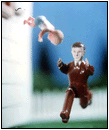|
Los Angeles Times Thursday, March 22, 2001 Their Dolled-Up
Dramas
By HOLLY MYERS, Special
to The Times
Copyright 2001
Los Angeles Times
|
Los Angeles Times
Thursday, March 22, 2001Their Dolled-Up Dramas
Artists Davis & Davis toy with psychological themes by photographing outcast items in charged scenarios, which says as much about them as their subjects.
By HOLLY MYERS, Special to The Times
If there were a purgatory for lost and forgotten toys, the team Davis & Davis might be appointed its resident art therapists. In their luscious color photographs, on view at the Watts Towers Art Center, Davis & Davis use toys they rescued from the streets and thrift stores to stage simple but poignant psychological dramas.
All of the photographs are still-lifes--inanimate dioramas involving only a few objects and props--but Davis & Davis' smart use of color and selective focus elicits a startling degree of animation and gives the images a potent narrative resonance.
Some of these dramas are lighthearted, approximating the imagined play of the toys' original owners. In one, an Eskimo doll and a polar bear figurine float on a raft of white styrofoam amid a sea of blue plastic, alongside a leaping whale. Others are darker, moving toward an exploration of the psychological conflicts that might have led to or accompanied the toys' abandonment. In one of the most riveting, a blond doll with the dress and demeanor of a drugged housewife, set amid a melange of domestic upholstery patterns, casts a look of dazed surprise at an overturned teacup and a bottle of bleach.
In reappropriating these lost and found objects, Davis & Davis tap into a dual sense of trauma (resonating from the child's loss of the object) and discovery (emerging from the recontextualization of the object for the adult viewer). While the artists' statement emphasizes the former--the concept of trauma--it remains an abstraction of somewhat questionable relevance.The images themselves, however, betray the artists' preoccupation with their own discovery of the objects. The toys in the photographs bear little physical trace of their troubled pasts; indeed they've been carefully cleaned up and glow with the sort of sheen bestowed only by an eager adult collector. The technical exactitude of the photographs seems to grow out of this collector's enthusiasm and contributes to the work's somewhat fetishistic quality. As a result, the photographs say less about childhood or the toys themselves than about the adult's stifled longing for play and discovery.
As is often the case with photography relating to children and childlike objects, a number of Davis & Davis' photographs fall prey to the cuteness of their subject matter, relying on its greeting-card potential rather than its more complex possibilities. There are, in other words, a few too many winking kewpie-like dolls in precious situations--one with angel wings, one on a beach, one in a field of daisies, one tangled up in toilet paper.
At their best, however, these photographs are strange and richly alluring. "Kristie," for example, features a standing doll with long blond hair and a denim dress against a solid pink background. The doll's dress only reaches the middle of her hips, leaving her undergarments partly exposed, and her arms are outstretched ominously toward the viewer. With her hair combed straight down, giving her a hippie-ish look and emphasizing the glazed quality of her expression, she is an intriguingly grotesque creature--a sexualized zombie girl trapped in a universe of bubble-gum pink.
In the best photographs, this strangeness is articulated through a gratifyingly clever use of focus and color. One of the most outstanding, "Candle Boy," is a nearly abstract well of undiluted color. This photograph features a baby-blue candle in the shape of a boy with his hands clasped behind his back against a wall of brazen yellow. Beneath his feet, on a peach-colored surface, is a small pool of brilliant red that strongly suggests a puddle of urine beneath the feet of a shy kindergartner. As in many of the other photographs, this simple combination of saturated colors--blue, peach, red and yellow--gives the work a deliciously surrealist edge that brings out the best in its potentially syrupy subject matter.

Watts Towers Art Center,
1727 E. 107th St., Los Angeles.
(213) 847-4646.
Through April 1. Closed Mondays.
Copyright 2001 Los Angeles Times